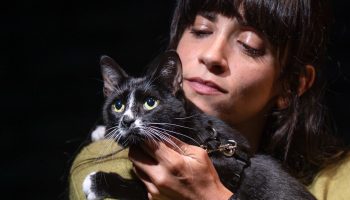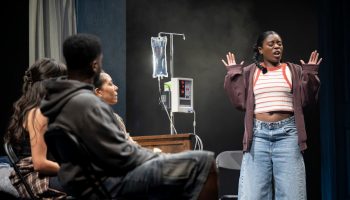
Julia Weber
Staff writer
Chautauqua Visual Arts’ latest exhibition is a thoughtful exploration of the systems — visible and invisible — that underpin our lives.
“Intersections & Diversions” is curated by Associate Director of CVA Galleries Erika Diamond. On view now through Aug. 20, the exhibition interrogates how artists use the grid structure as a way of organizing, connecting, building and structuring the world around them. The exhibition kicks off with an opening reception from 3 to 5 p.m. today in Strohl Art Center.
Thomas Campbell’s metal sculptures manipulate light and form through his alterations to the material. A fifth-generation steel worker, Campbell found his footing as a sculptor years into his job at his family’s metal shop.
“I was trying to take ownership of the skillset that I had developed in the industry, and that was a really eye-opening moment for me, realizing that I could take the skills that I had learned on these very utilitarian industrial applications and create something from scratch that was my own imagination,” he said.

Campbell’s works on view in “Intersections & Diversions” explore the spherical form and how metal can bend, refract and manipulate light.
“There’s a subtlety and softness informed that I’m so drawn to in the sphere,” he said. “I’m trying to see how minimal I can make these forms and still make them visually appealing.”
Though he has been working with the sphere for years, he never tires of it. To Campbell, it is an eternally interesting form with endless capacity for exploration of how it casts, bends and refracts light in enticing ways.
“I’ve been chasing that out the last few years: How subtle can I make these forms while they still interact with light?” he said.
Campbell said the intersections of his work stem from the give-and-take relationship of rigidity and softness. He alters the metal only minimally after he receives it from his distributor, aiming to highlight its qualities without overimposing on the specificities of each piece of metal he works with.
“My work has a rigidity to it, but also has a real softness to it,” he said. “I’m putting these subtle but very rigid bends in the material to then create this overall soft form. There’s this odd balance of the forms (that) feel very delicate, but also rigid at the same time to me.”

In contrast to the subtle differences in color and form of Campbell’s sculptures, Jayoung Yoon’s artworks use hair’s-breadth precision to explore the relationship to self and the natural world.
Yoon’s practice centers hair — her own and that of others’ — as an investigation of the intrapersonal relationship to one’s body and the natural laws by which we abide. What began as an interest in the process of bodily attachment to uncanny discard evolved into an exploration of materiality.
“I tried to visualize cleansing my memories through the materiality and process,” she said. “I found that hair has the potential to embody both mind and matter because hair is literally from the body, so it evokes physical sensibility.”
Employing this symbolism, her delicately crafted hair sculptures encourage reflection and stillness, stemming from Yoon’s interest in mindfulness and meditation.
In addition to mindfulness, she said she is interested in understanding the natural laws we abide by across disciplines — metaphysics, mathematics, art and more — in order to understand the “idea of inherent natural systems and (the) interdependence of all things.”

Her family’s heritage and experiences drove her to understand the human condition. Yoon said she found herself questioning “how we become aware of interdependence and cultivate compassion to make a better world.”
For her, hair as an artistic material is a way to represent these complex ideas in a universal way.
“I think it represents how we are all bound together in this fabric of existence,” Yoon said.
Meanwhile, Ellen Ramsey’s large-scale tapestries recreate the hardware that rules our lives. Portraying the circuits that power the digital world in which we operate, her weavings explore structure — both through its manifestation in the physical composition of a weaving and the digital infrastructure of the world.
“I am responding to technology and technological change from a historical perspective,” she said.
By training, Ramsey is an art historian, so she views societal transformation in a broad way and presents her research and questions about the role of technology in society through her weaving practice.
“I’m really interested in digital aesthetics, but what I dislike about digital art is the cold, hard screen and the mediated experience of digital art, so I enjoy weaving my versions of digital art and adding a human, handmade, imperfect and tactile object that still channels some of our interest in computer and computer ideas that we engage with all the time and think are fascinating,” she said.

Ramsey wants to impart upon viewers just how massive the role of these microelectronics — which are often taken for granted — are in our culture.
“If microelectronics existed in our world at a scale for how they impact our lives, they would be monumental,” she said.
Like the other artists in “Intersections & Diversions,” Ramsey uncovers hidden systems to explore the undercurrents of our lives in a new way.
“I want to surround you with life-sized, super-sized soft circuits that emphasize an architectural environment that we cannot see and a hidden infrastructure that we are completely manipulated by and can’t exist without, but we don’t see,” she said.




